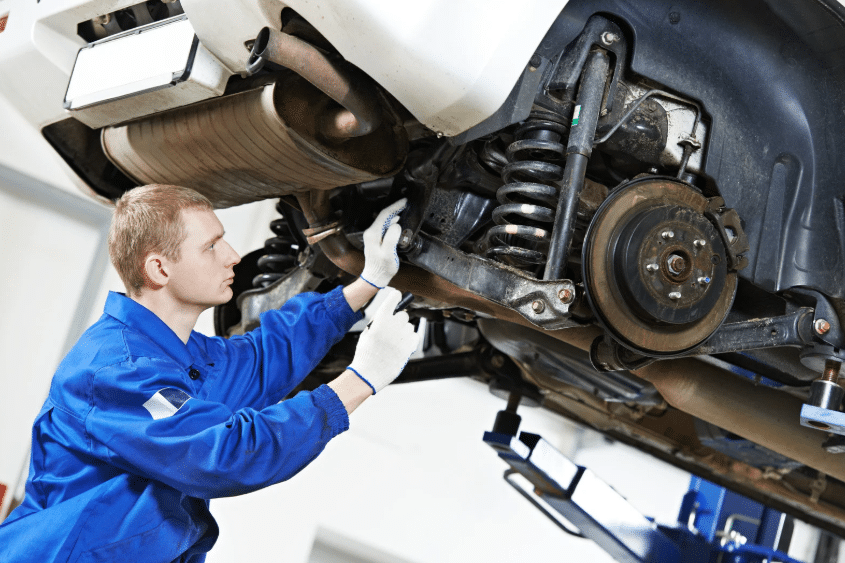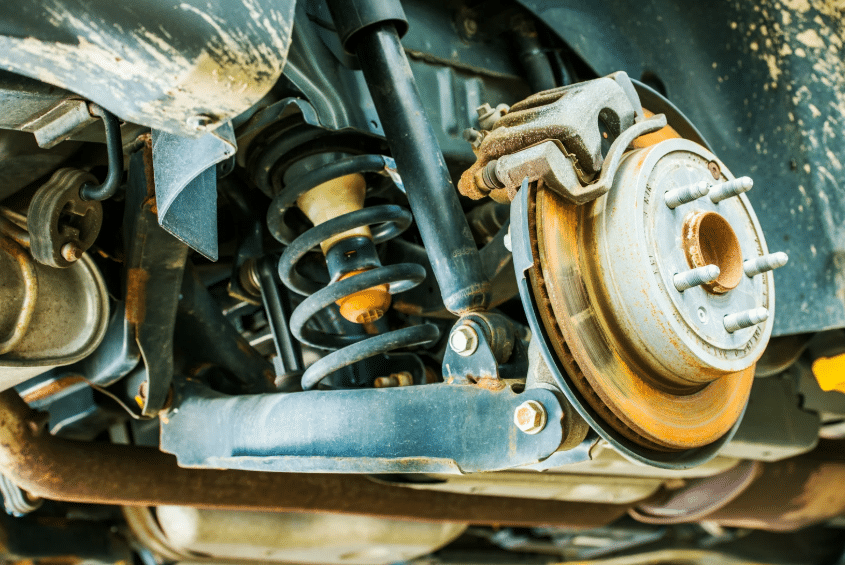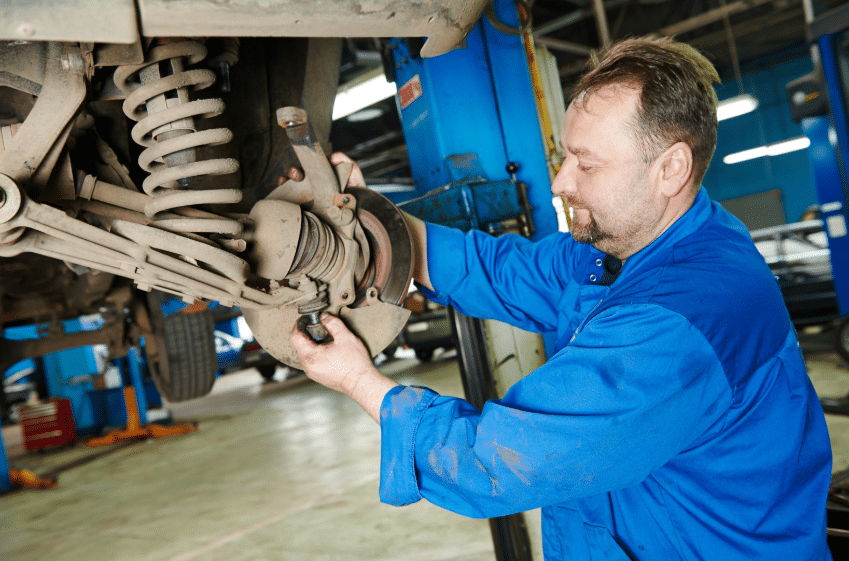Why a Suspension Check Matters: Protect Tire Life and Vehicle Safety

Sharing this:
Your vehicle's suspension system is more than just a comfort feature; it's a crucial safety component that affects everything from handling to tire wear. Many drivers overlook regular suspension checks until they notice severe problems like uneven tire wear or difficulty controlling their vehicle. By then, the damage often extends beyond the suspension components themselves.
As modern vehicles have evolved with increasingly sophisticated systems, so too have the diagnostic approaches needed to maintain them properly. The transformation from manual inspections to digital diagnostics has revolutionized how mechanics identify suspension issues, making preventative maintenance more accessible than ever.
Understanding why suspension checks matter can save you thousands in unexpected repairs while extending the life of your tires and ensuring your safety on the road. Let's explore the critical relationship between suspension health and vehicle performance, and why regular checks should be part of your car maintenance service.
The Critical Role of Your Suspension System

Your vehicle's suspension system connects your car to its wheels, absorbing shocks from the road and maintaining optimal tire contact with the surface. Properly functioning suspension components can improve braking distances by up to 22% on uneven roads.
Key components like shock absorbers, struts, springs, control arms, and bushings stabilize your vehicle. Even on smooth roads, your suspension constantly adjusts to maintain control, leading to gradual wear. This wear intensifies in stop-and-go traffic and rough driving conditions.
How Suspension Issues Accelerate Tire Wear
When suspension parts fail, even weight distribution across tires disappears, causing uneven wear patterns. Here are two of the most common tire wear problems caused by suspension issues:
- Cupping and Scalloping: Worn shocks and struts cause tires to bounce and form dips across the tread.
- Misalignment: Worn control arms or tie rods create improper wheel angles, resulting in uneven tires.
A full set of premium tires can cost $600-$1,200. Proper suspension maintenance can prevent premature tire replacement and ensure consistent road grip, reducing accident risks. If tire issues have already started, timely tire repair can help extend their lifespan.
Steering and Suspension: A Vital Partnership

Steering and suspension systems work together to maintain stability and handling. A well-maintained steering system ensures precise control, while suspension evenly distributes weight for consistent traction. Neglecting one system often compromises the other, leading to increased tire wear and unstable vehicle behavior.
Power steering issues, worn bushings, and misalignment are common culprits. Regular inspections help identify these problems early, preserving both safety and performance.
Safety Implications of Neglected Suspension
Faulty suspension components dramatically increase stopping distances and reduce vehicle control during emergencies. Electronic stability systems like ABS depend on consistent tire contact with the road, which a healthy suspension system ensures.
Understeer, oversteer, and poor weight transfer during turns all point to suspension problems. In emergency maneuvers, worn suspension parts can mean the difference between maintaining control and losing it.
Warning Signs Your Suspension Needs Attention
If you notice any of these suspension issues, it's time to schedule a car diagnostic service to identify and fix the root cause before it worsens:
- Excessive bouncing after bumps
- Clunking, knocking, or squeaking sounds
- Uneven tire wear (cupping, feathering, edge wear)
- Vehicle pulling or wandering while driving straight
- Sagging or tilting when parked
The Professional Suspension Check Process
Professional checks catch problems early, allowing for less expensive repairs and improved safety. A thorough inspection involves several steps:
- Visual Examination: Checking for leaks, cracked bushings, and damaged parts.
- Hands-On Testing: Feeling for excessive play in ball joints, control arms, and tie rods.
- Advanced Diagnostics: Using digital tools to measure shock performance and detect subtle faults.
- Alignment Verification: Ensuring wheel angles meet manufacturer specifications.
- Road Testing: Evaluating real-world handling and listening for noises.
Suspension Maintenance and Its Impact on Tire Wear
A healthy suspension system keeps tires evenly engaged with the road, reducing irregular wear patterns. Misalignment, worn shocks, and damaged springs compromise tire life and overall handling. Routine inspections and timely suspension maintenance, like replacing shocks, adjusting alignment, and maintaining proper tire pressure, protect your investment in both tires and vehicle stability.
Preventative Maintenance: Scheduling and Cost Considerations
Experts recommend a suspension inspection every 12,000-15,000 miles, or every 8,000-10,000 miles for vehicles frequently exposed to rough conditions. Comprehensive inspections typically cost $80-$150, far less than a full suspension overhaul or emergency repairs.
Proactive maintenance extends component life, enhances resale value, and keeps your vehicle safe. In addition to suspension care, keeping up with essential services helps maintain your vehicle's overall health.
Scheduling an oil change service at regular intervals protects your engine, while addressing potential issues early through coolant leak repair ensures optimal cooling performance. Staying proactive with critical systems like brake repair also plays a major role in keeping your vehicle safe on the road.
DIY vs. Professional Suspension Checks
Basic DIY checks (like the bounce test and visual inspections) can spot obvious issues. However, many problems require professional tools and expertise to detect.
Professionals use lifts, shock testers, and alignment machines to identify hidden problems before they escalate. A hybrid approach, regular owner checks combined with scheduled professional suspension inspections, offers the best protection.
Contact Blue Ridge Automotive to Protect Your Vehicle and Stay Safe

Your suspension system affects far more than ride comfort; it’s crucial for tire longevity, vehicle stability, and your overall safety. Regular suspension checks help catch small issues early, saving money and preventing accidents.
Blue Ridge Automotive is Atlanta's trusted source for expert steering and suspension repair, complete diagnostics, and preventative maintenance. Our ASE-certified technicians use the latest diagnostic tools to keep your vehicle safe and performing at its best.
Don't wait for signs like bouncing, pulling, or uneven tire wear. Protect your investment and your safety by scheduling a professional suspension check. Contact Blue Ridge Automotive today to get started!
Frequently Asked Questions
How often should I have my suspension checked?
For most vehicles under normal driving conditions, schedule a professional suspension inspection every 12,000-15,000 miles or annually, whichever comes first.
If you frequently drive on rough roads, carry heavy loads, or notice any warning signs like unusual noises or uneven tire wear, increase this frequency to every 8,000-10,000 miles. Remember that preventative maintenance almost always costs less than reactive repairs after component failure.
What’s the connection between alignment and suspension?
While related, these are distinct aspects of your vehicle's handling system. Your suspension components physically connect your vehicle to its wheels and absorb road impacts, while alignment refers to the precise angles at which your wheels contact the road.
Suspension problems frequently cause alignment issues, but alignment problems don't necessarily indicate suspension damage. However, proper alignment depends on healthy suspension components, which is why comprehensive suspension checks typically include alignment verification.
Can a damaged suspension cause other problems?
Absolutely. Compromised suspension components create a cascade of problems throughout your vehicle. Beyond the obvious tire wear issues, suspension problems place additional strain on steering components, wheel bearings, and even your vehicle's frame.
The constant vibration from poor suspension can damage electronic components and accelerate wear on the engine, transmission mounts, and even your car’s exhaust system. Additionally, the extra stress placed on remaining functional suspension parts and connected systems, like the transmission, accelerates their deterioration, creating a rapidly expanding cycle of damage.
What causes premature suspension wear?
Several factors accelerate suspension wear. Frequent driving on roads with potholes or uneven surfaces creates additional stress on components. Stop-and-go traffic conditions force your suspension to handle repeated weight transfers that accelerate wear.
Overloading your vehicle beyond manufacturer-recommended weight limits places excessive strain on springs, struts, and associated components. Environmental factors like road salt and extreme temperatures can accelerate corrosion and deterioration of rubber bushings. Regular maintenance can help mitigate these factors.
Are aftermarket suspension parts reliable?
Quality varies significantly across aftermarket brands. Premium aftermarket manufacturers often produce components that match or exceed OEM specifications, sometimes offering improved designs or materials that outperform original equipment. However, budget aftermarket parts frequently use inferior materials that deteriorate faster, leading to issues like premature car engine repair, oil leak repair, or even problems with your car’s AC system.
For optimal results, research specific brands and consult with experienced technicians who can recommend reliable aftermarket alternatives when appropriate. Remember that saving money on inferior components typically costs more in the long run through increased frequency of replacement and unexpected repairs.



